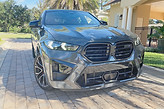
THE LEXUS 500h GROWS UP
Lexus didn’t quite invent the luxury SUV. That credit appropriately belongs to those WWII veterans, Jeep with its Wagoneer in 1963 and Range Rover’s launch in ’69. What Lexus did however, was a game changer that dramatically elevated its new brand and changed our vehicle landscape. In 1998 Lexus introduced its RX 300, an SUV based not on a truck chassis, but architecture from its ES 300 sedan. And this unibody construction, later labeled “crossover” from car to sports utility, was a huge hit for the newly minted brand.
Creating utility on a sedan platform is hardly new. For decades, station wagons did just that and those remaining still make competent family haulers. And the idea of putting a tall utility body on a sedan chassis belongs to Chrysler’s minivans that appeared in 1984. Credit aggressive marketing to elevate today’s sports utilities to a level of market dominance where some brands like Lincoln don’t even offer sedan options in their lineup.
Today’s Lexus RX continues to sit right in the sweet spot of SUVs and is still one of the brand’s top sellers despite being surrounded by other utility rivals in the showroom. One of RX’s stablemate challengers is the NX model that’s a bit smaller, more fuel efficient and less expensive than our RX 500h. In fact the NX 350h is about the same size as the original ’89 RX 300 and perhaps that attribute is not lost on some buyers.
Today’s Lexus styling, with its bold face and aggressive demeanor, has been the subject of many pundit keystrokes so I’ll resist weighing in with my opinion. Having said that, I’ll assert that bold usually wins over timid and memorable trumps bland every time. Do you remember Lexus style before the new look? Neither does anyone else, and I do like our test vehicle’s Copper Crest paint with black replacing what’s usually chrome brightwork.
Inside the new RX, the nicely bolstered leather seats are comfortable for long journeys and the visibility was reasonably open. Our vehicle was equipped with a digital rearview mirror option ($200) that provided a nice panorama from the rear camera when activated. That’s handy when you try to peek between rear passengers or cargo. And even when you’re not looking, the Lexus sensors are watching for other vehicles and pedestrians who may not pay attention. And like nearly all rivals these days, there’s generous video display up front with Apple Car Play and Android Auto systems to come along for the ride. There’s even a “Hey Lexus” command system onboard to speak to the RX robust computer interface.
Our RX 500h F-Sport model provided plenty of power with its 2.4-liter turbocharged 271 HP engine combined with another 95 HP from electric motors. The result propels the 4,750-lb RX from 0-to-60 in 5.9-seconds if you’re rushing the kids to school or soccer practice. Combined EPA fuel economy of 27 MPG isn’t bad in this class, but if you allow for a bit more time and can suffer less sportiness, the less powerful and thriftier RX 350h delivers a combined EPA of 36 MPG. That’s a welcome trade with today’s gas prices. Whichever model of RX you pick, it’s easy to see why it’s still one of the brand’s top sellers. Other rivals to consider are Acura’s MDX, BMW X5, Cadillac XT5 and Mercedes-Benz GLC 300.






